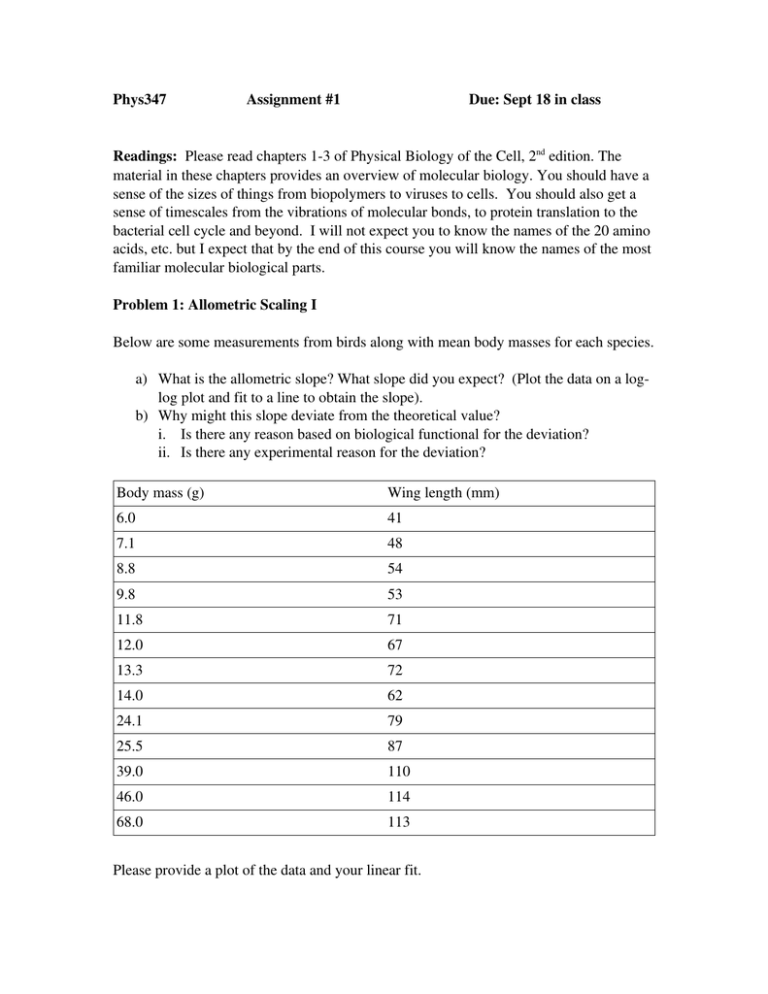Phys347 Assignment #1 Due: Sept 18 in class Readings: Please read chapters 13 of Physical Biology of the Cell, 2
advertisement

Phys347 Assignment #1 Due: Sept 18 in class Readings: Please read chapters 1­3 of Physical Biology of the Cell, 2nd edition. The material in these chapters provides an overview of molecular biology. You should have a sense of the sizes of things from biopolymers to viruses to cells. You should also get a sense of timescales from the vibrations of molecular bonds, to protein translation to the bacterial cell cycle and beyond. I will not expect you to know the names of the 20 amino acids, etc. but I expect that by the end of this course you will know the names of the most familiar molecular biological parts. Problem 1: Allometric Scaling I Below are some measurements from birds along with mean body masses for each species. a) What is the allometric slope? What slope did you expect? (Plot the data on a log­ log plot and fit to a line to obtain the slope). b) Why might this slope deviate from the theoretical value? i. Is there any reason based on biological functional for the deviation? ii. Is there any experimental reason for the deviation? Body mass (g) Wing length (mm) 6.0 41 7.1 48 8.8 54 9.8 53 11.8 71 12.0 67 13.3 72 14.0 62 24.1 79 25.5 87 39.0 110 46.0 114 68.0 113 Please provide a plot of the data and your linear fit. Problem 2: Allometric Scaling II As egg size increases among a group of egg­laying organisms (say, dinosaurs), would you expect egg shape to remain constant? Why or why not? If not, in what ways might you expect egg shape to change with size? Problem 3: Allometric scaling for walking speed You will see on allometric scaling tables that normal walking speed V is found empirically to scale with body mass as V = 0.5M 1/6 (m/s), i.e., as V = AM α with A=0.5 and α =1/6. Now let's see if we can understand the scaling exponent. Treat the leg as a simple pendulum and estimate a walking speed as the frequency of the pendulum times the step length. Show that the walking speed scales as V ~ M 1/6 . You will need to remind yourself of the frequency of a simple pendulum, and make this into a speed of stepping (hint: frequency is not a speed). The relationship will have lengths in it which you can then use our spherical human approximation to connect to mass. Problem 4: Bacterial Shapes Typically, large bacteria have the shape of a cylinder of fixed radius a and variable length L, where L >> a. (a) Show that the surface­to­volume ratio of these bacteria does not depend on the length of the bacterium (don't bother adding on the areas of the end caps). Contrast this with the surface­to­volume ratio of a sphere of radius R. (b) Explain why a large cylindrical bacterium can feed itself more efficiently than a large spherical bacterium. Assume that the bacteria feed by absorbing nutrients through their surface. To do this, compare the surface areas of cylindrical and spherical bacteria that have the same volume, and thus for the same food requirements. (You should assume that the radius of the cylindrical bacteria is smaller than the radius of the spherical bacteria, i.e. a << R). Problem 5: Important Units & Scales. 1. In the cell, forces are picoNewtons (pN) and the length scales are nanometers (nm). A molecular motor name Kinesin has a mass of about 100000 Da (dalton). One Da = 1.66 x 10­27 kg. (a) Calculate the force of gravity on kinesin and express it in pN. (b) Kinesin walks along microtubules and transports vesicles around the cell. The biggest force acting against it is viscous drag. kinesin can generate a maximum force of about 20 pN to overcome the drag forces that act against it. How many times its weight is this force? Think about this in comparison to how much the strongest humans can lift. 2. The most important energy scale inside a cell is kbT, where kb is Boltzman's constant (kb = 1.38 x 10­23 J/K) and T is room temperature, 295 K. Any energetic process that has an energy on the scale of kbT can be thermally activated. Many important biological bonds are only a couple kbT of energy. (a) Calculate kbT in terms of the familiar energy unit of Joules = 1kg.m. (b) Convert your result in (i) to the unit of work/energy most useful for cell biology, pN.nm. Problem 6: Estimating Numbers (Problems 2.3 & 2.1 from Physical Biology of Cell): 1. Sizing up the amount of carbon in an E. coli. (a) Make an estimate of the number of carbon atoms needed to make an E. coli. Assume that 50% of the dry mass of E. coli is made up of carbon atoms. The dry mass of E. coli is 0.3 pg. (b) E. coli are typically grown on minimal media which contains a starting concentration of glucose being 0.2 g/ 100 ml. Roughly how many E. coli cells can be grown on 5 ml of minimal media before the glucose runs out? The chemical formula for glucose is C6H12O6. It has a molar mass of 180 g/mol. 2. (a)Given that a typical bacteria (e.g. E. coli) is cylindrically shaped with a length ~ 2 m and diameter ~ 1 m, make an estimate of it's surface area and volume. (b)What fraction (i.e. %) of the volume of an E. coli cell is occupied by the DNA of its genome? E.coli has a genome that is 4.6 million base pairs (Mbp) long. (c)Roughly 2­3 kg of bacteria are harboured in your large intestine. Make an estimate for the total number of bacteria inhabiting your intestine. Estimate the total number of human cells in your body and compare the two results (assume that a human cell is spherical with a diameter ~ 10 m).






